Celebrate Iowa with Local Artists’ Work in Grinnell
Walking into the Grinnell Area Arts Council’s Arts Center in downtown Grinnell, visitors have a clear view of the Stewart Gallery. The space is distinctly divided down the middle of the room by colorful paintings and black and white photography. This stark contrast is the product of Dena Peterson and Bob Campagna’s exhibit entitled “Returning Home: Celebrating Iowa in Paint & Film.” Along the left wall and half of the back wall, Dena’s vibrant oil paintings of various Iowa landscape scenes hang. Almost every possible weather condition of the state is represented: bare trees in the early spring sunshine, flowers blooming near a pond, a summer rainstorm, autumn leaves falling from their branches and a hazardous snowstorm. Bob’s black and white photographs of the sights and people of Northeastern Iowa line the right wall, meeting Dena’s color in the back with his five portraits of Meskwaki people, who are members of a Native American settlement about 20 miles from Grinnell.
The pair decided to collaborate on this exhibit to showcase their love for the state and their overlapping philosophies behind their art. As artists in a state that some people struggle to find beauty in, they certainly don’t feel the same way.
Dana explained that many people think of the mountains or oceans as beautiful and think of Iowa as a flyover state, but it has its own beauty for sure. The fields, the rows leading your eye to the landscape. All of that really inspires her: the greens, the streams and rivers.
Her largest painting in the exhibit depicts a rolling country road surrounded by steady rows of farmland and a small church. In the distance, a car is beginning its descent down the hill. Further behind the car, storm clouds loom and rain has begun to fall in a streak of blue.
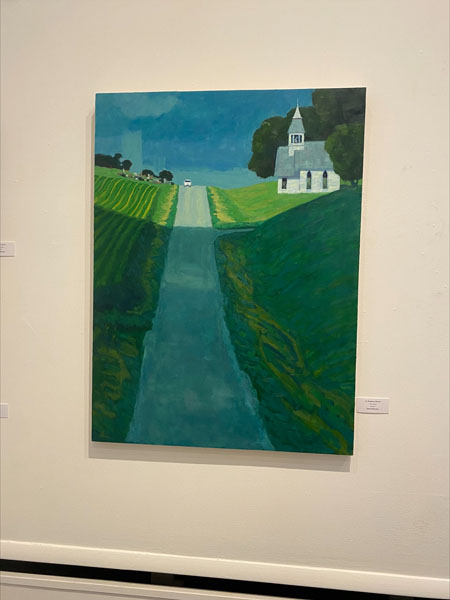
Bob holds similar sentiments saying Iowa is what he calls a ‘hidden treasure’ because people regard it as flyover, but having lived in Colorado, it is no greater than the beauty of Northeastern Iowa.
At the exhibit's edge is a cluster of four metallic prints of four abandoned houses. Conventionally thought of as rubble, Bob turned these houses into works of art through his photography.
After seeing the exhibit, Dena hopes visitors will walk away “… seeing Iowa through my eyes and through Bob’s eyes and seeing the beauty that we see.”
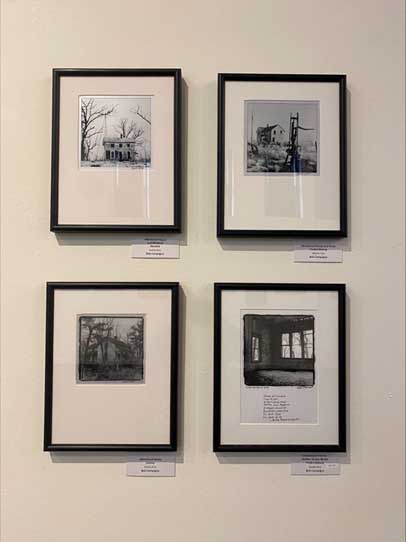
The pair met while living in Loveland, Colorado, when Dena’s daughter was one of Bob’s photography students. Dena’s Iowa roots come from her mother’s family who farmed in the Southeastern part of the state and her father’s parents in Grinnell. She was born and raised in Illinois, but often visited family in Iowa and now lives in Grinnell. Bob is a lifelong Iowan, hailing from Mt. Vernon, apart from the 13 years he spent in Colorado.
They both returned to Iowa in recent years and decided to collaborate on this exhibit and their book, “Of Light and Moment,” which is available for purchase at the Stewart Gallery. The book expands on their vision for the exhibit with each page featuring one painting and one photograph that each connect with the other, often through the shapes or lighting within them. Though their art appears dramatically different upon first glance, many similarities lie within how the two approach their art and the world in general. They share a similar vision or eye for composition.
In her paintings, Dena strives to create something more than just the subject of her painting. She has a deep love for the process of painting and hopes for it to result in something more than just a replica of her subject. By leaving clear brush strokes and simplifying the shapes and lighting, she can create more interpretive representations of the world around her.
Bob finds ways to incorporate this interpretive theme into his photography. Though photography is inherently more literal than painting, he differentiates his black and white film from color film. The lack of color allows for more artistic freedom as it removes one of the literal elements of the moment. The process of his dark room development also opens his work up for more editing of reality. Within 100 versions of the same photograph, each one contains slight variations.
Interpretation comes into play especially with Bob’s five portraits of Meskwaki tribal members. On each canvas, the image appears in a unique pattern of splatters and veins on the white background, only revealing parts of the literal photograph. The final piece is a painted photograph that was created using a chemical process with an eyedropper, a spray bottle and Bob’s own fingertips to trace the unique shapes. With this method, each final piece is truly one of a kind with no chance of being replicated. It also gives Bob the freedom to weave more meaning into his work. In the case of the Meskwaki portraits, he was able to depict deeper themes surrounding the Ghost Dance, a Native American belief that spirits of the dead would rise again to fight off European settlers.
He tried to replicate what’s coming up out of the ground. Bob explained that the viewer sees strong lines coming from the soil and that’s the ghost rising from it to get rid of the white man..
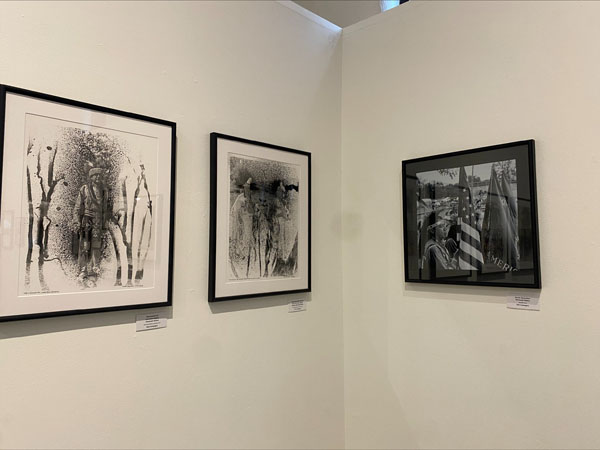
A few other pieces stand out to Dena and Bob themselves specifically because of the narrative that surrounds the moment their piece captures. The only painting of Dena’s that includes a person is entitled “Disappearing,” and it features her mother partially hidden behind greenery and several monarch butterflies. Every aspect of the painting appears to be in the middle of a vanishing act. The bright orange from the monarchs’ wings streaks across the canvas, and the green crowds the old woman’s face.
The purpose of Dena’s recent return to Iowa was to help with the care of her parents who were both in memory care at the time. Before her mother’s passing, Dena received a picture of her mother from the care facility with a monarch butterfly perched on her arm. She thought about the monarchs and their numbers decreasing and how this was similar to her mom and how her mind was just disappearing. She doesn’t usually do narrative paintings, but this one she did for herself … disappearing like the butterflies, yet still a beautiful moment of fragments.
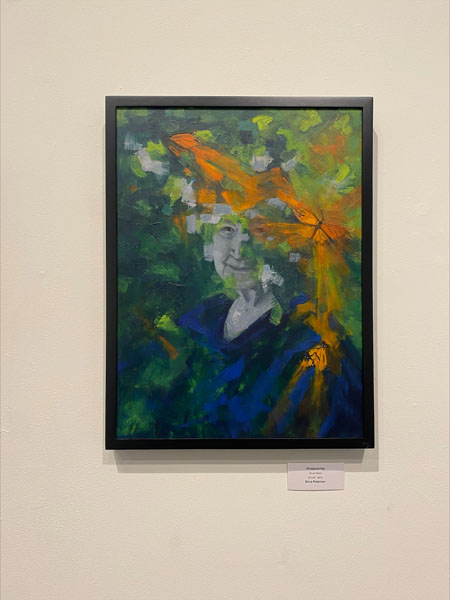
In the Stewart Gallery, underneath the sign for the exhibit a piece from each of them hangs. Bob’s photograph entitled “Bill Young Feeding His Hogs.” As the title promises, a man in overalls holds a bucket of feed in front of several pigs with his barn in the background. Bill Young isn’t alone in this photograph, though. In front of him stands a ballerina on pointe, her arms gracefully posed.
“The hog farmer snuck up behind me when I was photographing the ballerina in the middle of the street and he wanted to be photographed with his dog. In a way, that moment was ‘get out of the way or be a part of it.’ So he says ‘be a part of it.’ After I photographed him and his dog in his old truck, his next words were ‘I’ve got a hog lot, you wanna come dance in it?’ And how can you turn that down?” Bob explained how this unplanned interaction resulted in one of his signature photographs. He does not underestimate the significance of serendipity in art and life.
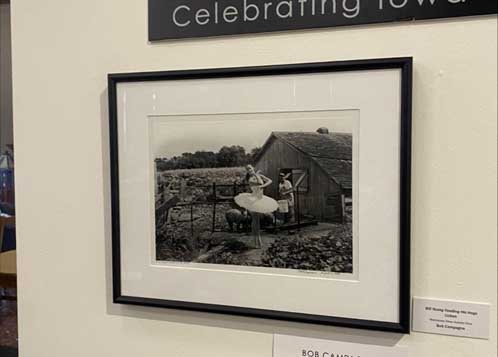
Their book’s back cover holds the most succinct way to describe who the duo draw inspiration from in the art world. Two separate quotes act as reviews of “Of Light and Moment”:
“I’d give my left ear to own a copy of this book!” – Vincent Van Gogh
Dena’s work as a painter is heavily influenced by Van Gogh and other impressionists such as the Group of Seven located in Canada. She was selected as one of 120 international artists to contribute to the film “Loving Vincent.” During her time on the film, she was touring the Auberge Ravoux, the inn where Van Gogh lived during his final months of life. Van Gogh would paint on the inn’s tea towels because he did not have the money to afford canvases. Dena was asked to paint her own tea towel piece, which remains in the Ravoux’s collection.
“I immediately stopped photographing the High Sierras just to read this book.” – Ansel Adams
A long-lived source of inspiration for Bob has been Ansel Adams, a photographer known for his work in the United States National Parks. Despite his great affinity for Adams, Bob identifies what landscapes, perspectives and moments are “missing” in Adams’ work and fills in those gaps with his photography. One of the roots of Bob’s work focuses on what only he can see because of his unique and underappreciated location in Iowa.
To further explore Bob and Dena’s deep appreciation for Iowa, stop by the Stewart Gallery at 926 Broad St. in Grinnell before Saturday, July 6. The gallery is open to the public Tuesday – Friday from 11 a.m. – 5 p.m. and Saturdays 10 a.m. – Noon, and admission is free of charge.
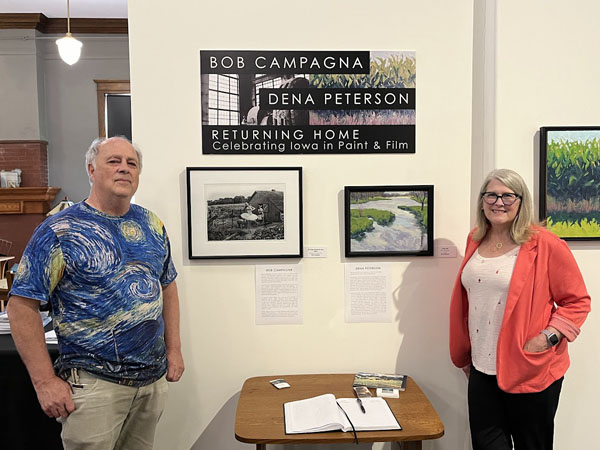
Contact Grinnell Area Arts Council or Bob and Dena
For more information about the Grinnell Area Arts Council, visit grinnellarts.org or call (641) 236-3203. For more information about Bob or Dena’s work, visit abbecreekgallery.com or denapaints.com respectively.
The Greater Des Moines Partnership calendar of events is a one-stop resource for activities taking place throughout the region. Find networking information for Greater Des Moines (DSM) businesses, including Chamber luncheons, roundtables and ribbon cuttings. You can also find live music happening each week thanks to the “Live Music This Week in DSM” blog series.